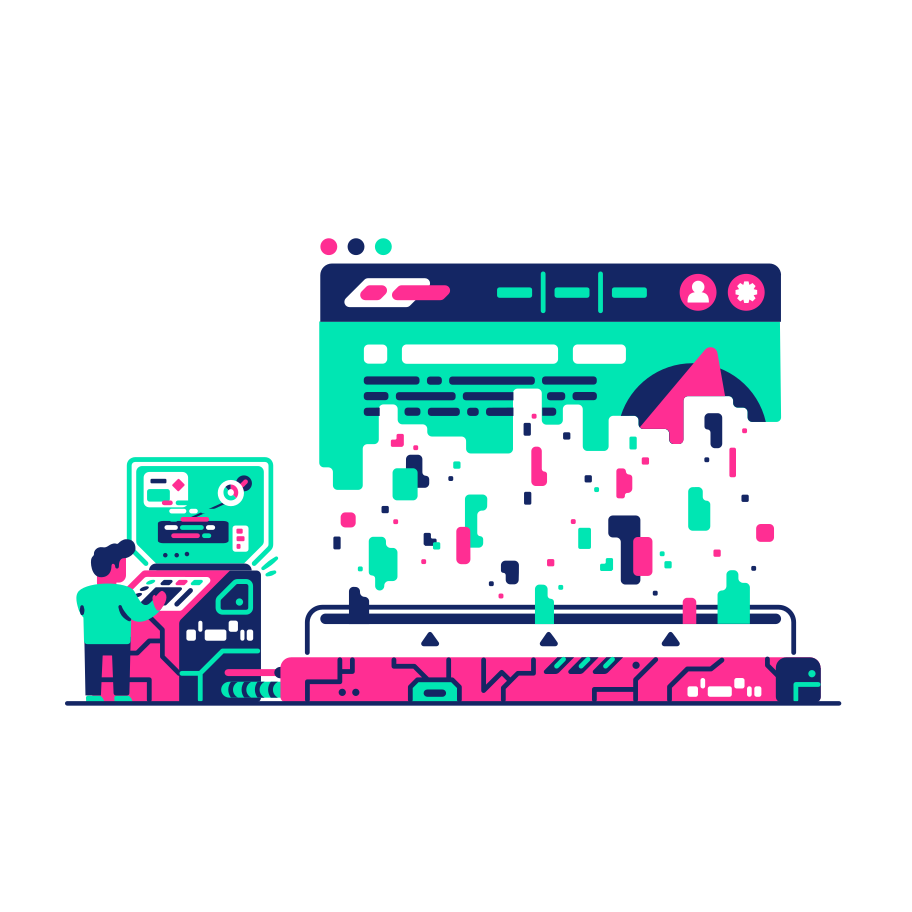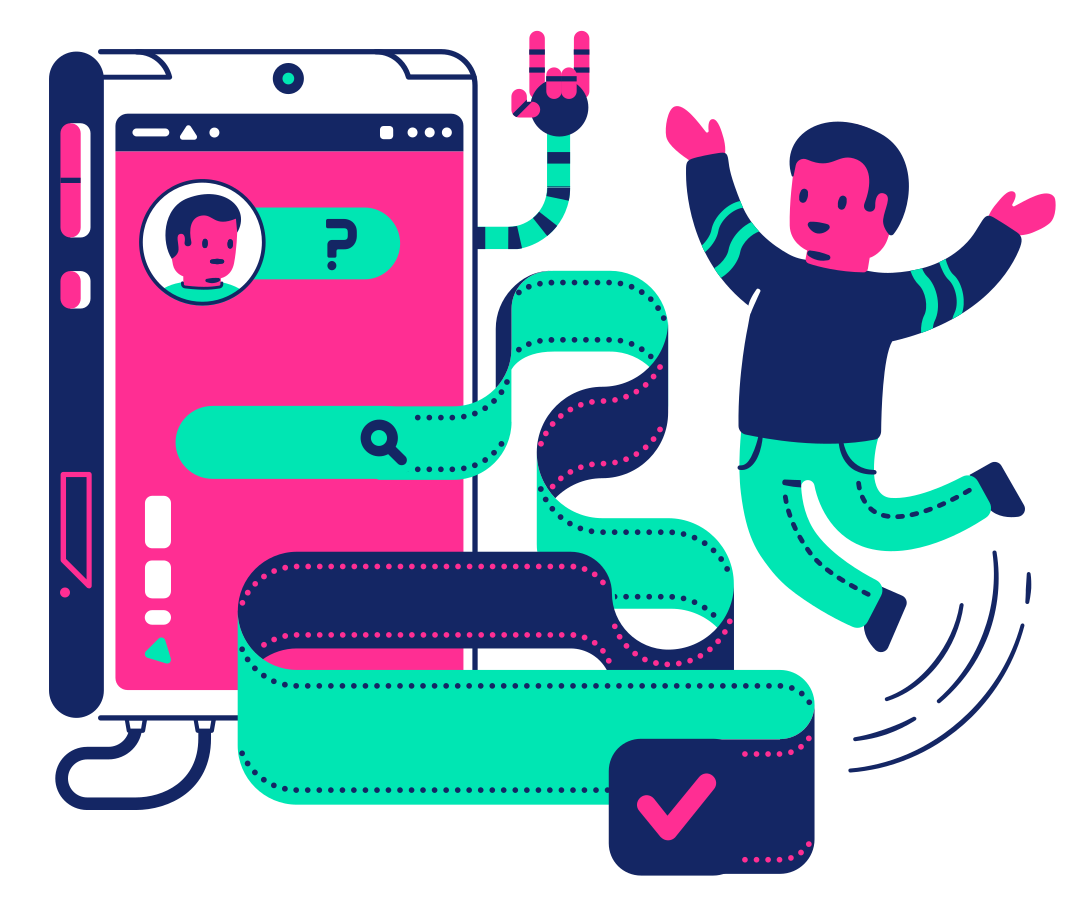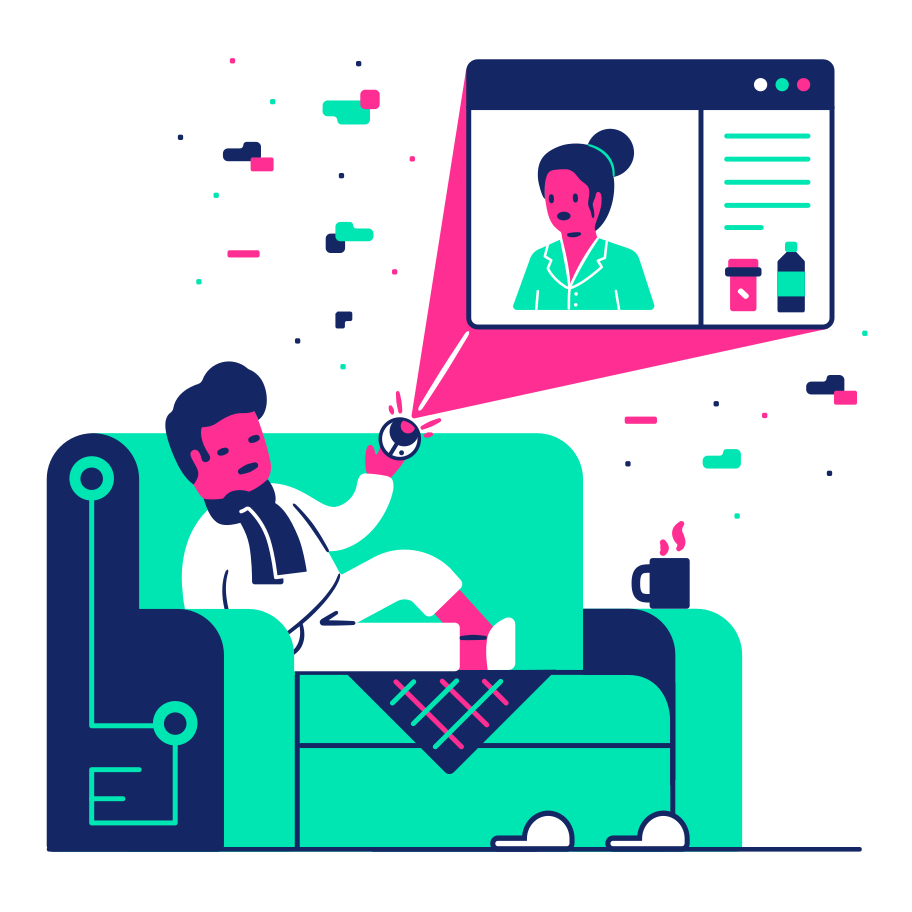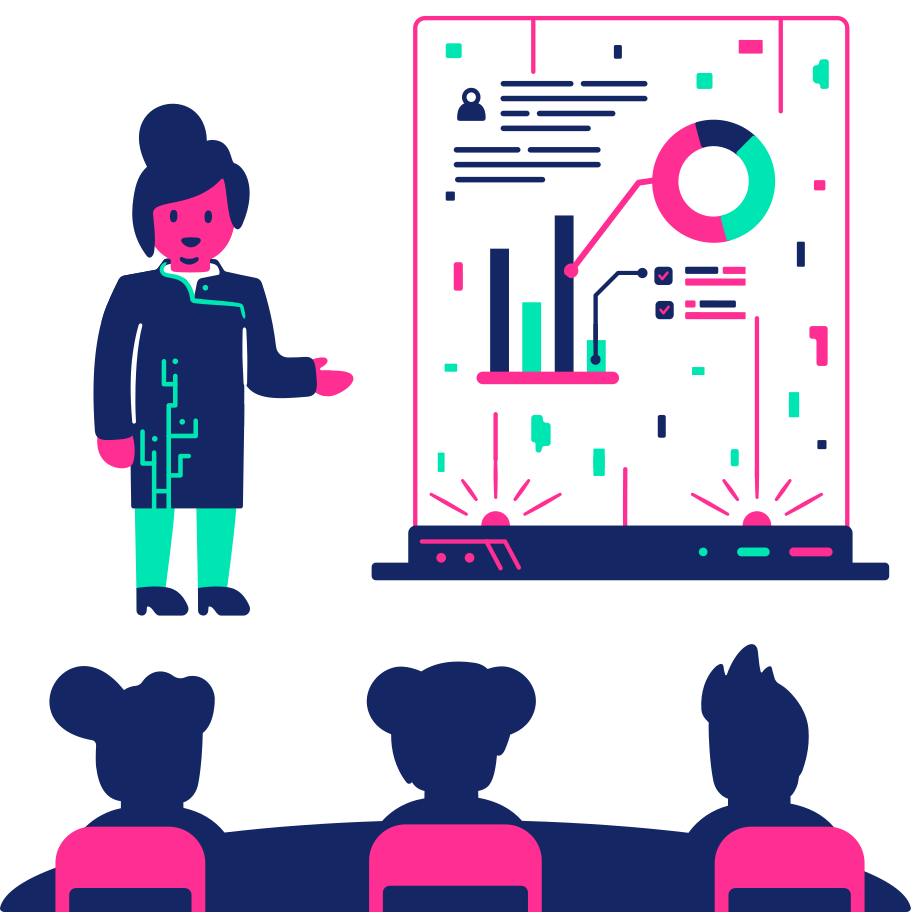Are you interested in learning more about what a UX designer, or user experience designer, does?
Maybe you're thinking about jumping into the field but want to learn more before making any definitive moves.
UX design is a fascinating field that combines many other disciplines into one. Specifically, UX designers sit at the intersection of product design, market research, interaction design, product strategy, human computer interaction, visual design, and more!
We wouldn't blame you for an interest in jumping into an exciting and diverse career like UX design.
We wrote this article to provide you with everything you need to know about what a UX designer does so you can judge if this is the right career for you.
Let's get to it!
In this guide, you'll learn:
- What Is UX Design?
- What Are the Responsibilities of a UX Designer?
- What Are the UX Designer Job Duties?
- What Are the Top UX Designer Skills?
- What Is The Between UX and UI?
- How to Become a UX Designer
What Is UX Design?

First and foremost, we should provide a little recap on what UX design is. UX, or user experience, design is a discipline, as the name suggests, that is all about how users interact with products or services.
One of the famous examples of excellence in user experience is the unboxing experience of the iPhone.
Believe it or not, Steve Jobs had packaging designers hard at work opening box after box. Then, finally, one with the perfect drag, the ideal amount of friction was found.
This little experience, smoothly opening up the box, is just one example of the UX of the iPhone.
As you can imagine, UX is a complex and varied design discipline. It is also highly multidisciplinary, incorporating aspects of design, tech, behavioral psychology, marketing, and more.
UX design was first developed by Don Norman, who was actually working at Apple at the time. He first referred to the discipline as "user-centric design," but the overall concept and goal was the same. That is, to create a seamless user experience.
While a novel concept in the mid-1980s, UX design has grown substantially and is a staple at nearly every modern company. After all, if a company isn't investing in UX design, their competitors surely are!
What Are The Responsibilities of A UX Designer?

So if that's what UX design is, what do UX designers typically do on a day-to-day basis?
Needless to say, they are expected to wear many hats and could be tasked with many different dimensions of UX design, such as industrial design, usability, visual design, etc.
In a nutshell, a UX designer is expected to ensure products or services are developed in a way that takes the users' needs and desires into account.
At the end of the day, if a product/service isn't satisfying, usable, accessible, or desirable for customers, they're simply not going to use it.
You'll typically find a UX designer working with or acting as members of a larger product team at most companies. As such, they are responsible for connecting the user with the larger product development teams, company stakeholders, and members of upper management.
The end-user is the cornerstone of the UX designer position. Everything revolves around them and the experience they'd have using the product.
However, UX designers must still ensure that the user experiences they are designing align with their organizations' business goals.
A UX designer can potentially be responsible for many different tasks or projects. However, there are some general job responsibilities all UX designers are tasked with. These are:
- Performing user research
- Developing user personas
- Defining information architecture
- Creating user flows and wireframes
- Building prototypes
- Running user tests
We'll cover these duties in more detail in the section below.
What Are The UX Designer Job Duties?
As we just mentioned previously, the job responsibilities of a UX designer can really be all over the map depending on the company and the particular product. However, there are some primary broad-strokes job duties.
These are:
Performing User Research

Despite the title of "designer," one of their principal job duties is performing UX research. In most cases, this is in the form of user research.
Think about it: how can they design product experiences based on user needs/wants if they don't know what those needs/wants are?
Specifically, a UX designer must conduct user research focused on consumers' behavior, motivations, and requirements to help other designers and development teams recognize market opportunities and act accordingly.
User research is usually conducted before product development is underway. However, this is not always the case. There is always room for user research at every stage of the development cycle.
UX designers are expected to use qualitative (subjective, descriptive; how a user feels about a product) and quantitative (objective, statistics; produces metrics and data) methods when conducting user research.
These methods will typically include user surveys, focus groups, data collection, A/B testing, etc.
Developing User Personas

Along with digging deep into the company's users, UX designers are also responsible for using that data to develop actionable user personas. A user persona is a character or archetype of a specific kind of user that shares particular traits or needs with the larger group.
Here at Exponent, we have a user persona of a Junior PM. They have worked only at one large tech company before their new job. Transitioned to a much smaller, scrappy startup that follows very different processes, she has difficulty finding her ground. So she’s turning to Exponent resources to help navigate a really challenging time where she’s struggling with imposter syndrome.
In most cases, entire User Personas can consist of 1-2 page documents covering everything from user behavior, motivations for using the product, attitudes, and other pertinent contexts.
As we mentioned, User Personas are not necessarily closeups of a real, specific user. Instead, they are semi-fictional stand-ins for larger groups.
A UX designer will routinely include fictional details to make thee personas more realistic. For instance, a common practice includes attributing quotes from real users to the user persona.
Like user research, developing user personas is a significant and influential part of a UX designer's responsibilities. They are ultimately vital for a company's growth and development.
Defining Information Architecture

UX designers are also involved with defining information architecture (IA). This terms refers to how information is organized and outlined.
Information architecture could involve building the structure of apps, websites, or other products. This is an essential aspect of user experience. Imagine if a user was navigating through an app, but the architecture was convoluted or confusing. Needless to say, their user experience will be poor.
UX designers will need to structure the IA of their product or service so that the end-users can readily move through and interact with it.
Creating Wireframes and User Flows

UX designers also must create wireframes and user flows. Wireframes are product design sketches meant to illustrate what the products will look like. Typically, these wireframes will consist of mostly UI design elements.
A user flow is a diagram meant to map user behavior with the product. So drafting these diagrams is likely what you'd think of when considering what user experience design means.
Building Prototypes

UX designers are integral parts of those teams that produce product prototypes. Building prototypes is a necessary part of product development. In addition, these initial products are later tested by sample users.
Not only that, but usually, building prototypes will lead to product insights that are implemented later in the development cycle.
While other teams, such as engineering or design, will also be involved in building prototypes, UX designers are responsible for ensuring that they are built with user experiences resembling the final product.
Running User Testing

UX designers are also tasked with running user testing sessions. These practices are similar to the user research we mentioned previously. However, these tests are typically conducted with final design prototypes (near the end of the product development cycle rather than the beginning).
User testing simply means letting sample users use the prototype. Afterwards, they will solicit user feedback.
These tests may focus on one or several aspects of the user's experience, such as the UI design or usability testing.
While this kind of testing, as we mentioned, usually occurs towards the end of a product's lifecycle, it is an essential step in identifying what changes need to be made before the product is ready for its release.
What Are The Top Skills for UX Designers?
As you can imagine, with such a diverse scope of responsibilities, there are many UX design skills.
Like other tech roles, a UX designer will need both hard and soft skills. They also need a combination of technical and aesthetic skills. These are:
Top UX Designer Technical Skills

Research Skills
UX Designers need to have the research skills to conduct user interviews, surveys, and observations, the insights of which help to direct UX design decisions.
Proficiency in Developing Information Architecture
As we mentioned, developing IA is crucial for UX designers, so they must be proficient in doing so to be successful.
Wireframing
UX designers will be doing a lot of wireframing. You can think of this as the skeletal framework for websites and apps.
Prototyping
Along with wireframing, UX designers are also tasked with building prototypes of their products. This is ultimately an essential skill for identifying potential problems or improvements before releasing the final product.
Visual Design Fundamentals
It's also essential for some UX designers to have a solid grasp of visual design fundamentals. While it's true that UX designers are not graphic designers, visual and graphic design is still an essential dimension of a high-quality user experience.
Top UX Designer Soft Skills

Communication
UX designers will need to communicate with various stakeholders at their organizations and the end-users themselves, during both user research and testing.
Empathy
At the end of the day, a UX designer cannot effectively design an incredible experience for the user if they cannot empathize with them and step into their shoes.
Collaboration
UX designers work alongside many other teams. As such, UX designers will need plenty of cross-functional collaboration skills to flourish in their roles.
Critical Thinking
Finally, UX designers will need to display plenty of critical thinking skills to develop solutions to the problems faced by their end-users.
Of course, this is not a definitive list of all the UX design skills you may need.
Depending on the organization's size, a UX designer may also be expected to have web development or UX writing skills. This is especially true of startups or smaller early-stage companies.
Despite the wide range of skills necessary for the position, many of them are not necessarily unique to UX design. This means that you can easily pick them up and develop them from other fields.
What Is the Difference Between UX and UI?
UX designers will undoubtedly be involved with designing aspects of a product's UI (if it has one). However, there is a difference between UX and UI.
First of all, UX stands for user experience, and UI stands for the user interface. In short, UX consists of everything to do with how a user interacts with a product or service. On the other hand, user interface is confined to only the graphical interface (things like an app's buttons, fonts, layout, etc.).
Many organizations, especially larger ones, will have both UX and UI designers who will work together. However, some UX designers will also be expected to act as UI designers.
How to Become a UX Designer

As is the case for any diverse or multifaceted role, many different ways and career paths lead to becoming a UX designer.
As we have seen, there are dozens of different skills that you can first acquire from many other roles, such as industrial design, software engineering, graphic design, architecture, and more.

However, suppose you want to become a UX designer. In that case, you can try some of the following ways to jump into user experience:
Complete a UX Design Course
There's a lot that goes into UX design. While you don't need a college degree to get a UX designer job offer, you will need to know how to perform the various duties that come along with it.
If you don't come from a background where you could have developed these skills, you should consider completing a UX design course or class.
This will provide you with the fundamentals you need to succeed and a certificate that you can show to potential employers.

Product Designer Interview Course
Our Product Designer Interview Course teaches you how to ace the product designer interview, and is applicable to the UX design interview, visual design interview, and user researcher interview. This course is created by product designers from Google, Meta, and more.
Whether provided by bootcamps or other professional development organizations, UX Design courses can give you the direct experience you need with UX or interaction design tools to jump into the field.
They can also provide you the opportunity to build a portfolio, which is an absolute must for ultimately receiving job offers.
Develop UX Design Experience Wherever Possible
If you're new to the field, it may be difficult to find chances to build up your portfolio enough to get a decent UX designer job. This could feel frustrating; how can you gain experience and build a portfolio if you can't first get a job?
Luckily, it doesn't necessarily matter where this experience comes from. So, take advantage of any opportunity to complete a UX design project.
For instance, you can volunteer your services to local organizations or charities. You could complete some projects for friends and family. You could even complete some projects for yourself!
Also, another common practice amongst aspiring UX designers is redesigning the UX of some product or service to beef up their portfolios. These "unsolicited redesigns" could consist of any part of a product's user experience, whether it be interaction design or user interface design.
This could be an effective tactic that can impress a hiring manager and give you a leg up on your competition (especially if you are redesigning a product from the company you are applying to).
Assemble a UX Design Portfolio
UX design is one of those careers that is less rigid about its job requirements. So, for example, you don't necessarily need a university degree in UX Design to get a job.
However, what is non-negotiable is a design portfolio that demonstrates your user experience skills.
Without this, hiring managers will have no tangible way of evaluating your chops as a UX designer besides the experience laid out on your resume. It's unlikely that you'll be invited to many interviews without a UX design portfolio.
You must collect all your previous projects in one place. It doesn't necessarily matter where these projects came from or why you completed them, so long as they showcase your skills. For example, they could be from previous courses, volunteering, internships, or personal projects.
UX Design Frequently Asked Questions
Is breaking into UX design difficult for new designers?
Suppose you have no prior experience in UX design or some of its related disciplines. In that case, you may find it a bit difficult to learn at first.
It also depends on whether you come into the role from a previous development or design background.
For instance, if you have a background in design, the aesthetic and artistic aspects of UX design may come more naturally to you. After all, you should know all about color theory, elegant typography, image layout, etc. Nevertheless, you may find the technical parts of UX design, such as user research and A/B testing, have a steep learning curve, and vice versa.
Focus on showcasing your strengths and relevant skills from your education or previous work experience, and demonstrate an openness to learning the skills you haven't worked on yet.
Do I need to go to college to become a UX designer?
No, you do not. It is possible to become a UX designer without a college degree dedicated to the discipline. In fact, many UX designers enter the field from other roles.
Nevertheless, you need to have all the various skills and a portfolio to demonstrate them to receive a job offer.
It also betters your chances of entering the UX field and flourishing in the role if you have previous experience in other positions such as product design, graphic design, web development, or market research.
Nevertheless, many UX designers have degrees in computer science or graphic design.
What are the typical UX designer salaries?
According to Glassdoor, UX Designers make around $115,000. However, UX designer compensation can vary depending on the company and your experience.
For instance, Associate UX Designers at LinkedIn make around $200,000 in total compensation.
Do I need to know how to code to be a UX designer?
It's improbable that you will be required to code as a UX designer.
Even so, previous computer science or web development skills on your resume may help give you a leg up on your competition. After all, UX design is a complex and multifaceted discipline.
Therefore, a well-rounded or diverse background of skills can do nothing but help you receive a job offer in the end.
Are UX design bootcamps worth the time and money?
In general, yes, UX design bootcamps are worth the time and financial investment and are a valid form of UX design education.
As we mentioned a few times previously, aspiring UX designers must have a portfolio of real projects that showcase their design skills. This may be a challenging thing to obtain for those without previous experience.
UX Design Bootcamps, however, can quickly provide that along with an education in the discipline. In addition, many bootcamps also include career planning assistance or networking opportunities you can leverage to get a job in UX design.
More Resources
Here at Exponent, we've connected tens of thousands of job seekers in countless tech roles with expert courses and resources to prepare them for their upcoming interviews.
If you're interested in more design-related resources, be sure to check out:
👨🎓 Take our complete Product Design Interview Course.
📖 Read through our company-specific interview guides
👯♂️ Practice your behavioral and interviewing skills with our mock interview practice tool.
Browse product designer interview questions
Learn everything you need to ace your product designer interviews.
Exponent is the fastest-growing tech interview prep platform. Get free interview guides, insider tips, and courses.
Create your free accountRelated Courses

UX & Product Design Interview Prep

Salary Negotiation Course
Related Blog Posts

Prepare for the UX Designer Interview (Questions and Answers)

Creating a UX Portfolio to Land the Job: A Step-By-Step Guide



